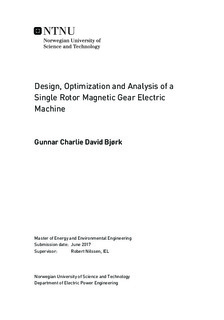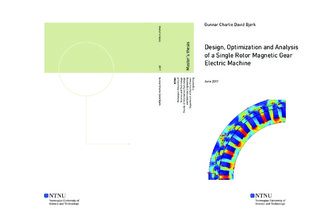| dc.description.abstract | Magnetic gears have recently become serious contenders for mechanical gears in low speed applications that require high torque. A magnetic gear features benefits such as inherent overload protection and low maintenance, while having torque handling capabilities similar to mechanical planetary gears. In this thesis an integrated magnetic gear brushless permanent magnet machine is designed, optimized and analyzed
for use in marine applications. This type of machine uses the principles of a magnetic gear within a synchronous machine, and preliminary investigations have shown that they exhibit very good torque capabilities.
The machine is developed through a careful design process, which is validated by the finite element method in COMSOL multiphysics. During the design process heavy calculations are performed on a supercomputer, which enables the computation
of very large parametric sweeps. Parallel to manually designing a machine, a particle swarm optimization of the same design, under similar limitations is performed on a supercomputer. The results from both design processes are compared and it is concluded
that the particle swarm method is a powerful tool that should be used actively during design. However it is also found that the particle swarm optimization should be controlled and iterated by a machine designer, in order to make the design feasible in
practice.
The resulting machine designs achieve torque densities of 98.8 kNm/m3 and 105.9 kNm/m3 respectively, which make them relevant contenders to existing direct-drive solutions in terms of compactness. However low power factors of 0.187 and 0.188 means that they require large and expensive converters which is undesired in marine applications. Along with a quantitative analysis of losses in the machines the results are also reviewed qualitatively.
An alternative method of describing the principle of the magnetic gear is adopted from the Vernier reluctance machine, and the connection between these is clearly shown. This will hopefully make the operating principle more intuitive to understand. | |

